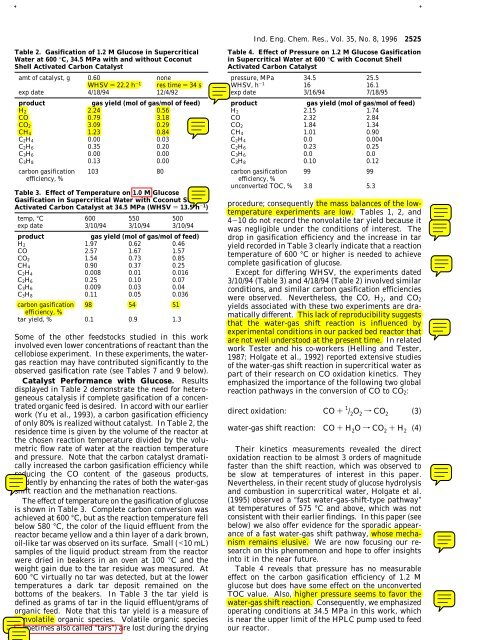Carbon-Catalyzed Gasification of Organic Feedstocks in ...
Carbon-Catalyzed Gasification of Organic Feedstocks in ...
Carbon-Catalyzed Gasification of Organic Feedstocks in ...
Create successful ePaper yourself
Turn your PDF publications into a flip-book with our unique Google optimized e-Paper software.
+ +<br />
Ind. Eng. Chem. Res., Vol. 35, No. 8, 1996 2525<br />
Table 2. <strong>Gasification</strong> <strong>of</strong> 1.2 M Glucose <strong>in</strong> Supercritical<br />
Water at 600 °C, 34.5 MPa with and without Coconut<br />
Shell Activated <strong>Carbon</strong> Catalyst<br />
amt <strong>of</strong> catalyst, g 0.60 none<br />
WHSV ) 22.2 h -1 res time ) 34 s<br />
exp date 4/18/94 12/4/92<br />
product<br />
gas yield (mol <strong>of</strong> gas/mol <strong>of</strong> feed)<br />
H 2 2.24 0.56<br />
CO 0.79 3.18<br />
CO 2 3.09 0.29<br />
CH 4 1.23 0.84<br />
C 2H 4 0.00 0.03<br />
C 2H 6 0.35 0.20<br />
C 3H 6 0.00 0.00<br />
C 3H 8 0.13 0.00<br />
carbon gasification<br />
efficiency, %<br />
103 80<br />
Table 3. Effect <strong>of</strong> Temperature on 1.0 M Glucose<br />
<strong>Gasification</strong> <strong>in</strong> Supercritical Water with Coconut Shell<br />
Activated <strong>Carbon</strong> Catalyst at 34.5 MPa (WHSV ) 13.5 h -1 )<br />
temp, °C 600 550 500<br />
exp date 3/10/94 3/10/94 3/10/94<br />
product<br />
gas yield (mol <strong>of</strong> gas/mol <strong>of</strong> feed)<br />
H 2 1.97 0.62 0.46<br />
CO 2.57 1.67 1.57<br />
CO 2 1.54 0.73 0.85<br />
CH 4 0.90 0.37 0.25<br />
C 2H 4 0.008 0.01 0.016<br />
C 2H 6 0.25 0.10 0.07<br />
C 3H 6 0.009 0.03 0.04<br />
C 3H 8 0.11 0.05 0.036<br />
carbon gasification 98 54 51<br />
efficiency, %<br />
tar yield, % 0.1 0.9 1.3<br />
Some <strong>of</strong> the other feedstocks studied <strong>in</strong> this work<br />
<strong>in</strong>volved even lower concentrations <strong>of</strong> reactant than the<br />
cellobiose experiment. In these experiments, the watergas<br />
reaction may have contributed significantly to the<br />
observed gasification rate (see Tables 7 and 9 below).<br />
Catalyst Performance with Glucose. Results<br />
displayed <strong>in</strong> Table 2 demonstrate the need for heterogeneous<br />
catalysis if complete gasification <strong>of</strong> a concentrated<br />
organic feed is desired. In accord with our earlier<br />
work (Yu et al., 1993), a carbon gasification efficiency<br />
<strong>of</strong> only 80% is realized without catalyst. In Table 2, the<br />
residence time is given by the volume <strong>of</strong> the reactor at<br />
the chosen reaction temperature divided by the volumetric<br />
flow rate <strong>of</strong> water at the reaction temperature<br />
and pressure. Note that the carbon catalyst dramatically<br />
<strong>in</strong>creased the carbon gasification efficiency while<br />
reduc<strong>in</strong>g the CO content <strong>of</strong> the gaseous products,<br />
evidently by enhanc<strong>in</strong>g the rates <strong>of</strong> both the water-gas<br />
shift reaction and the methanation reactions.<br />
The effect <strong>of</strong> temperature on the gasification <strong>of</strong> glucose<br />
is shown <strong>in</strong> Table 3. Complete carbon conversion was<br />
achieved at 600 °C, but as the reaction temperature fell<br />
below 580 °C, the color <strong>of</strong> the liquid effluent from the<br />
reactor became yellow and a th<strong>in</strong> layer <strong>of</strong> a dark brown,<br />
oil-like tar was observed on its surface. Small (
















